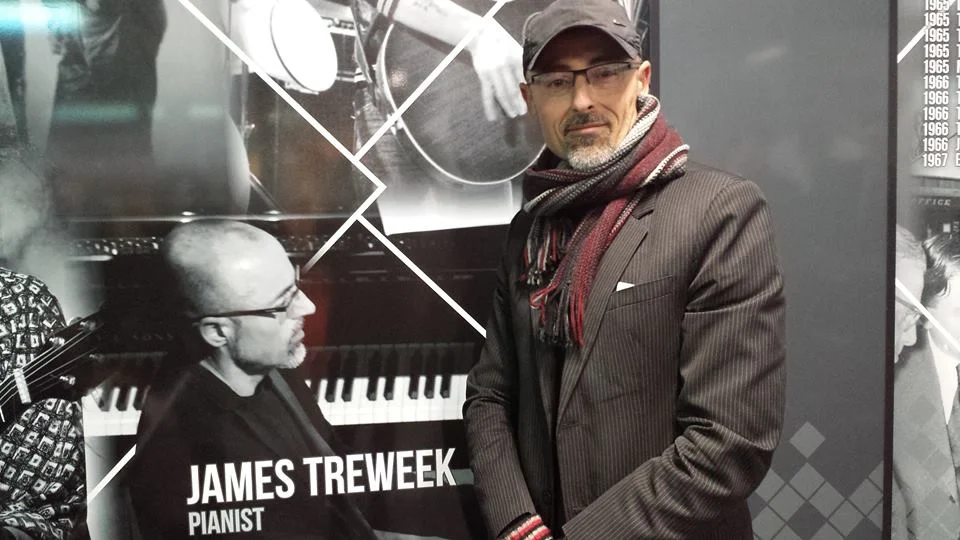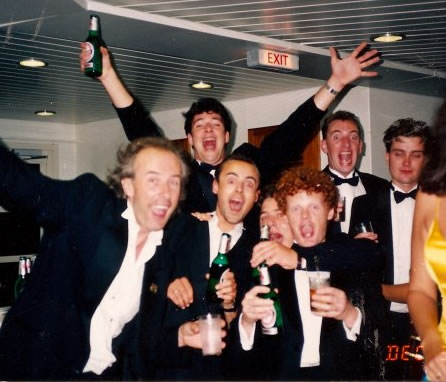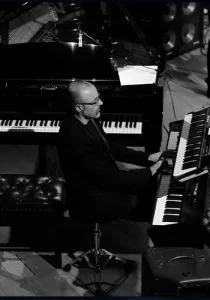General
James Treweek – Recognition In The Arts
2015 had an unexpected start this January when I was honoured to be included in a mural in Stevenage (Hertfordshire) recognising people working in the arts, who grew up in the town. Arts personalities from the worlds of theatre, film, sculpture and literature joined the guest list for the event at Stevenage Leisure Centre. The life size photo murals were unveiled by Stevenage Mayor and Gordon Craig Theatre patron, actress Vikki Michelle. An earlier set of panels saluting some of the town’s sporting stars, including Lewis Hamilton, was unveiled last year. The unveiling event was a lovely, relaxed affair attended by most of the artists in the mural, including author Ken Follet and fellow Spice Fusion Big Band member Giles Terera!
Arts personalities from the worlds of theatre, film, sculpture and literature joined the guest list for the event at Stevenage Leisure Centre. The life size photo murals were unveiled by Stevenage Mayor and Gordon Craig Theatre patron, actress Vikki Michelle. An earlier set of panels saluting some of the town’s sporting stars, including Lewis Hamilton, was unveiled last year. The unveiling event was a lovely, relaxed affair attended by most of the artists in the mural, including author Ken Follet and fellow Spice Fusion Big Band member Giles Terera!  The photo used (taken by the wonderful composer Lester Barnes) was from a recent album launch concert where I was playing a Steinway D concert grand, my Roland 700NX and Korg x50. I’ve been concentrating on piano playing throughout 2014 (I’m back working on the smartassmusic.com again now!) and for a look at the kind of thing I’ve been doing over the past year here’s a great video featuring fellow Stevenage mural artists :-) myself (James Treweek) on piano and Giles Terera on vocals.
The photo used (taken by the wonderful composer Lester Barnes) was from a recent album launch concert where I was playing a Steinway D concert grand, my Roland 700NX and Korg x50. I’ve been concentrating on piano playing throughout 2014 (I’m back working on the smartassmusic.com again now!) and for a look at the kind of thing I’ve been doing over the past year here’s a great video featuring fellow Stevenage mural artists :-) myself (James Treweek) on piano and Giles Terera on vocals. 




 Good luck,
James Treweek
Pianist, arranger, composer
Good luck,
James Treweek
Pianist, arranger, composer  The “Holy Grail” for pianists is to find an “effortless” technique which allows them to be at one with the instrument. This is something that has interested me for the past 20 years and which I believe I’m beginning to gain some understanding of. I’ve been meaning to blog about this for ages but it’s such a huge subject!
The “Holy Grail” for pianists is to find an “effortless” technique which allows them to be at one with the instrument. This is something that has interested me for the past 20 years and which I believe I’m beginning to gain some understanding of. I’ve been meaning to blog about this for ages but it’s such a huge subject! Stan Sulzmann is constantly in demand as a guest soloist and has appeared with bands across Europe, including the Hilversum Radio Orchestra, NDR Big Band (alongside Chet Baker), Hanover Radio Symphony Orchestra and the New York Composers Orchestra. His career stretches back to the 60’s, where he drew critical acclaim playing alongside Graham Collier, John Taylor, Kenny Wheeler, Gordon Beck, as well as leading many groups of his own. Since that time Stan has been at the forefront of European contemporary jazz, and has been in demand by musicians such as Gil Evans, Mike Gibbs, Kenny Clarke/Francy Boland and Michael Brecker.
Stan Sulzmann is constantly in demand as a guest soloist and has appeared with bands across Europe, including the Hilversum Radio Orchestra, NDR Big Band (alongside Chet Baker), Hanover Radio Symphony Orchestra and the New York Composers Orchestra. His career stretches back to the 60’s, where he drew critical acclaim playing alongside Graham Collier, John Taylor, Kenny Wheeler, Gordon Beck, as well as leading many groups of his own. Since that time Stan has been at the forefront of European contemporary jazz, and has been in demand by musicians such as Gil Evans, Mike Gibbs, Kenny Clarke/Francy Boland and Michael Brecker.
 Nick Smart (trp) is another musician who constructs intelligent, swinging solos with a beautiful tone. Nick has performed with numerous groups including the Stan Sulzmann Big Band, London Jazz Orchestra, Michael Garrick Big Band, BBC Big Band and is the regular soloist with the James Taylor Quartet.
Nick has been increasingly sought after in jazz education. Currently Jazz Co-ordinator and Bmus Tutor at the Royal Academy, he teaches the Jazz LRAM pedagogical diploma and directs the Big Band. Under Nick’s direction recent Big Band projects have included performances with Peter Erskine, John Taylor, Stan Sulzmann and Kenny Wheeler. Nick is also currently on the faculty at the Guildhall School of Music and Middlesex University, as well as a regular tutor on various Jazz summer schools including Glamorgan, Wavendon, Burnley and Trinity.
If you get a chance to see either (or both) of these great British Jazz musicians you really won’t be disappointed.
Nick Smart (trp) is another musician who constructs intelligent, swinging solos with a beautiful tone. Nick has performed with numerous groups including the Stan Sulzmann Big Band, London Jazz Orchestra, Michael Garrick Big Band, BBC Big Band and is the regular soloist with the James Taylor Quartet.
Nick has been increasingly sought after in jazz education. Currently Jazz Co-ordinator and Bmus Tutor at the Royal Academy, he teaches the Jazz LRAM pedagogical diploma and directs the Big Band. Under Nick’s direction recent Big Band projects have included performances with Peter Erskine, John Taylor, Stan Sulzmann and Kenny Wheeler. Nick is also currently on the faculty at the Guildhall School of Music and Middlesex University, as well as a regular tutor on various Jazz summer schools including Glamorgan, Wavendon, Burnley and Trinity.
If you get a chance to see either (or both) of these great British Jazz musicians you really won’t be disappointed.  Holidays are well and truly over now and although I’m hanging onto the last of the Indian summer we’re having in Britain (I’m still in shorts!), there’s no denying the workload which is building and it’s time to get back to the blog :-)
The summer has been full of
Holidays are well and truly over now and although I’m hanging onto the last of the Indian summer we’re having in Britain (I’m still in shorts!), there’s no denying the workload which is building and it’s time to get back to the blog :-)
The summer has been full of  You must first imagine the beat (and “groove” or various subdivisions of the beat), then the harmony……. and only then you start to play! If you cannot conjure up these aspects before you play then it’s highly likely that you’re music won’t be very good.
If you’re a visually inclined thinker then the image to the left may make sense to you. This is quite literally what I see very often when playing. If you’re not visually oriented…. don’t be put off!
You must first imagine the beat (and “groove” or various subdivisions of the beat), then the harmony……. and only then you start to play! If you cannot conjure up these aspects before you play then it’s highly likely that you’re music won’t be very good.
If you’re a visually inclined thinker then the image to the left may make sense to you. This is quite literally what I see very often when playing. If you’re not visually oriented…. don’t be put off! 
